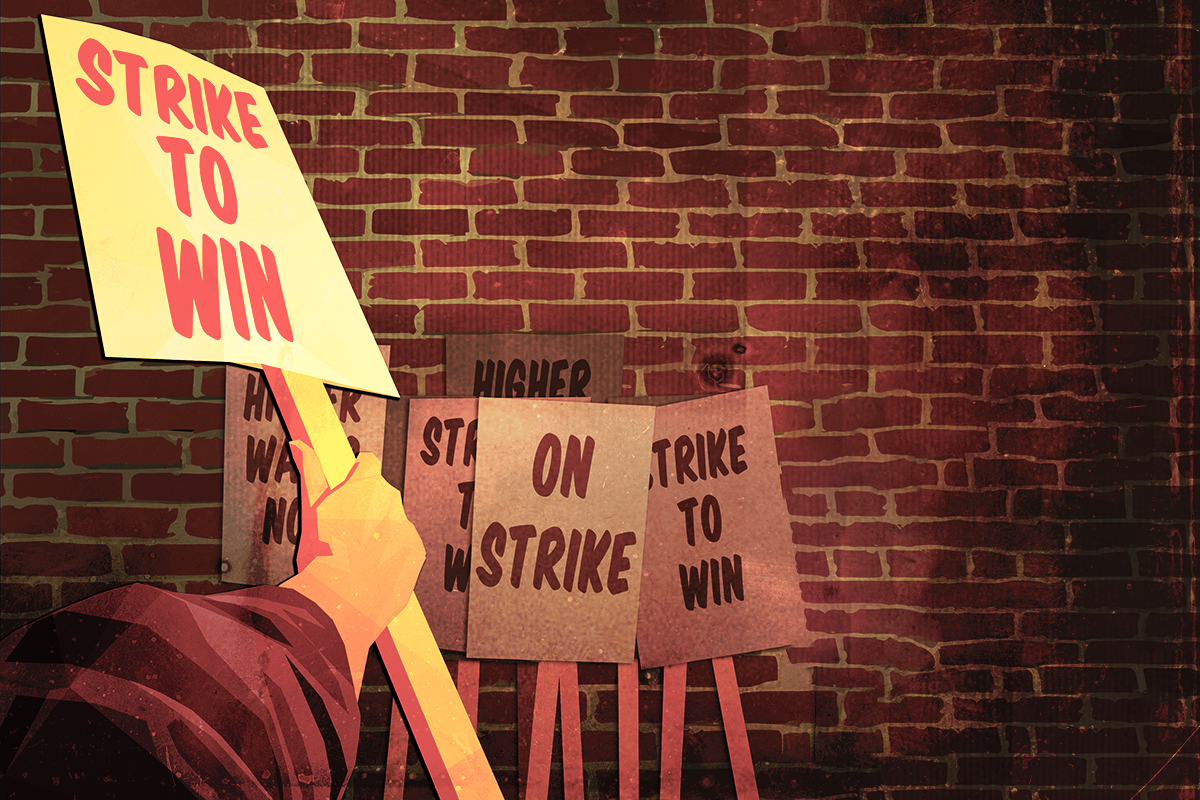
The following document outlining socialiste’s perspectives for class struggle in Canada was adopted by the 2023 congress of Fightback/La Riposte
In Canada, misery and disillusionment abound. Nobody is happy. The 2020 wave of national unity seen during the first stages of the pandemic has been replaced by cynicism, anger, and polarization. Institutions, parties, and bureaucracies stand, but only because there hasn’t yet been the organized force to push them over. Beneath the surface their foundations are crumbling. There is a widespread feeling of malaise, but this distress is merely the precursor to an explosive outburst. Dissatisfaction cannot last forever without inevitably finding an outlet. This document aims to track these processes in order to ideologically arm socialist workers and young revolutionaries so that we can prepare for the coming storm.
Numerous polls have detailed that a majority of Canadians believe that the country is heading in the wrong direction. Upwards of 50 per cent are angry about how Canada is being managed and 67 per cent agree that everything feels broken. This contrasts with 2020 when there was a wave of patriotic national unity behind governments implementing pandemic measures. In 2020, 58 per cent thought the government was heading in the right direction, while in late 2022, 65 per cent believed the nation was on the wrong track.
There are similar polls for federal and provincial leaders, with almost all of them gaining a boost in 2020, before being viewed cynically today. Justin Trudeau for example had a stratospheric 63 per cent approval in May 2020, while in early 2023 he is hated by almost as many people. Some leaders like Alberta’s Jason Kenney, and Manitoba’s Brian Pallister were not able to survive and have been forced out in disgrace. The general feeling is dissatisfaction with current leadership, while also having little enthusiasm for the alternatives that are on offer.
Another manifestation of malaise is the historically low turnouts seen in elections. Bourgeois “democracy” has a growing crisis of legitimacy. Turnout in federal elections approximated 75 per cent in the 1960s, 70s, and 80s. But since the turn of the 21st century it has hovered around 60 per cent. The situation in the provinces and municipalities is even worse. For example, only 43.5 per cent voted in the 2022 Ontario election. The parties that govern do so on an increasingly shaky foundation, with Justin Trudeau holding a mandate from only 20 per cent of eligible voters. Meanwhile, Ontario’s Doug Ford seeks to push through policies that he kept secret without even gaining the support of 18 per cent of the electorate.
Some have said that these polls are meaningless. The irony being that those saying this are also often disillusioned themselves. We ask if a “wrong direction” poll is meaningless, then isa poll saying the country is moving in the “right direction” also meaningless? It is true that people can oppose the status quo for both left- and right-wing reasons, and these polls do not say what people want as an alternative. But the first task of our analysis is to ascertain whether the liberal “middle” is strong or weak. All evidence points to a weakening and rejection of the status quo and a growing polarization to the left and the right.
The reasons for this are very clear to see. Economically there has been a massive transfer of wealth from the poor to the rich and this process is accelerating. Tent encampments are becoming a common feature of every city in Canada. Longer and longer lines of people are queuing up for food parcels in scenes reminiscent of the 1930s. There is a generalized feeling of collapse.
During the pandemic, workers were told that “we are all in this together”. However, the degree of assistance given to the different classes shows massive disparities. The right wing love to demonize recipients of the $2000 per month Canada Emergency Response Benefit (CERB), going after every worker who made even the smallest mistake in their paperwork. However, they are conspicuously silent about the far greater sums of taxpayers money that were gifted to corporations. The end value of CERB/CRB was $103 billion, while the cost of corporate welfare was $786 billion. Often these handouts merely served to pad dividends, executive bonuses, and share buyback programs. Additionally, the Canada Revenue Agency regularly writes off loans to corporations, while showing no leniency with workers.
In the aftermath of the pandemic workers have to cope with historically high inflation. The rising cost of living is making workers poorer in real terms. In 2021 private sector workers received a three per cent wage increase while inflation was 4.8 per cent. In 2022 wages grew by 5.1 per cent, compared with 6.8 per cent inflation. In other words, workers’ wages are losing almost two per cent of their value every year. Anecdotally, the wage gap appears to be even higher in unionized and public sector contracts which only received two or three per cent in 2022.
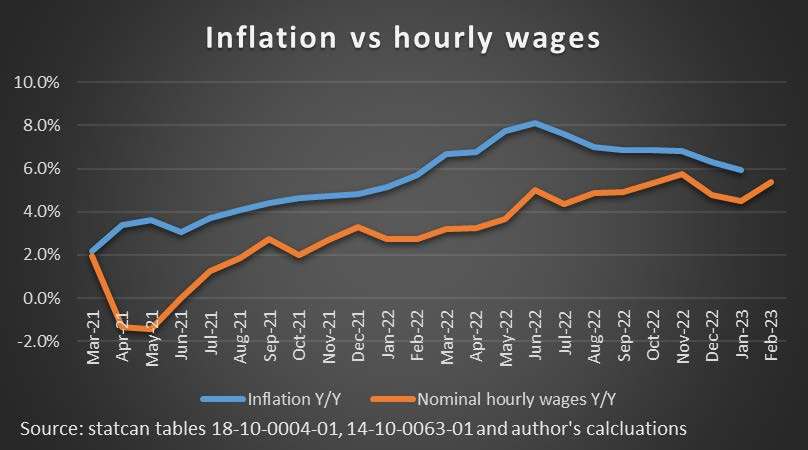
On the other side of the class divide, the bourgeoisie is doing very well for themselves. Corporate profits in the second quarter of 2022 amounted to $441 billion. This marks a 130 per cent increase over two years! While workers have been losing purchasing power CEO pay also shot up by 31.2 per cent in 2021, to an average of $14.3 million per year.
The incredible disparity between the profits of the corporations and the living standards of the people was highlighted by the scandal of a package of five chicken breasts being sold for $37. This was at the same time as Loblaws had increased its retail profit margin by 10 per cent to 30.8 per cent.
All of these factors combine to feed dissatisfaction, anger, and polarization.
Marxist foresight vs capitalist astonishment
Inflation has arisen as the number one concern for working class people. Polls have shown that it is the top issue for 61 per cent of the population. The fact that the rising cost of living is also concentrated in food and housing makes this an incredibly pressing matter for workers.
After 30 years of relatively low inflation, the ruling class is quickly coming to understand that the rapid increase in prices erodes social cohesion. This was even acknowledged by Tiff Macklem, the governor of the Bank of Canada, when he said, “It’s been a long time since we had high inflation and we’re rediscovering that it corrodes the social fabric. It makes people angry. People feel ripped off. And that’s one of the big problems with inflation and it’s an important reason why we got to get it back down.” From the perspective of the ruling class, the risk of inflation outweighs the risk even of an economic slow down. This explains why the Bank of Canada has pursued policies that risk provoking a recession such as hiking interest rates from 0.25 to 4.5 per cent in the span of a year. However, due to their class position, the capitalists are condemned to never be able to understand where inflation comes from.
Today, Macklem is blaming workers’ wages for rising prices. This is despite the fact that wages have consistently lagged behind inflation. Ignoring this, Macklem continues to reference a non-existent “wage-price spiral” as the cause of increased prices and demands that bosses push down wages.
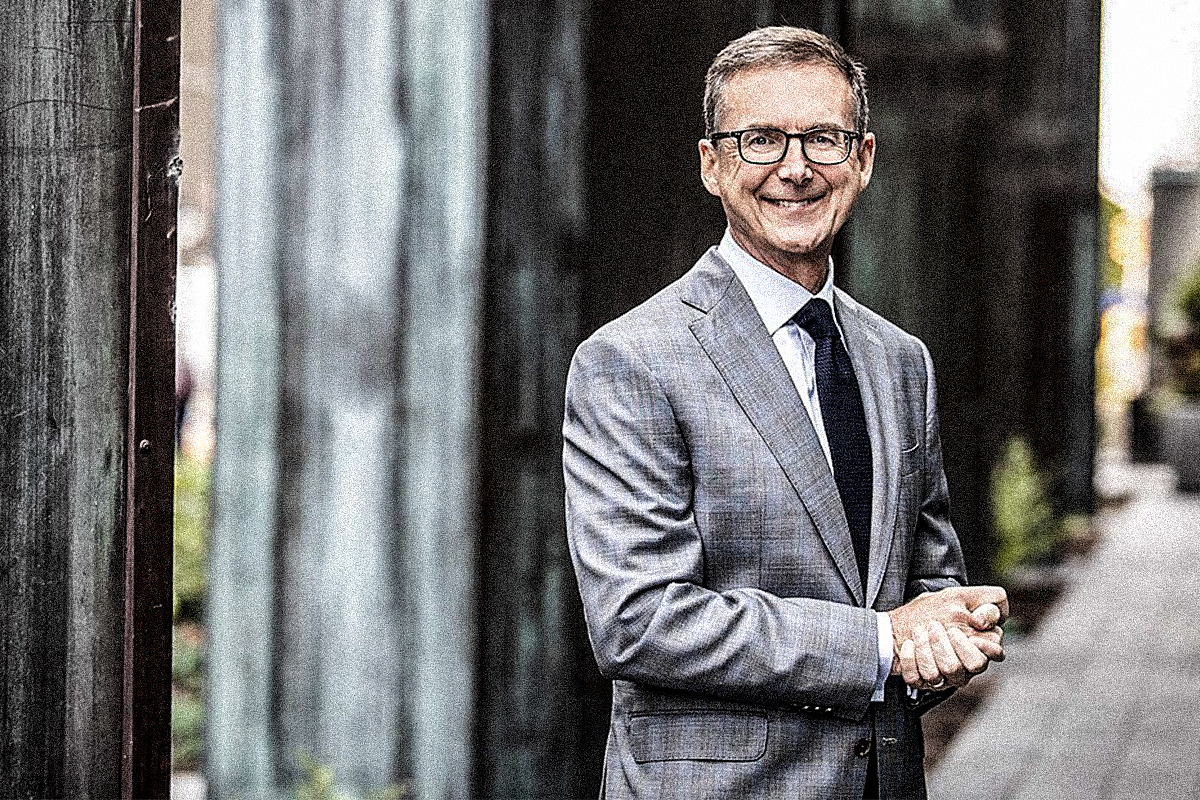
Basing itself on simplistic ideas of supply and demand, the Bank of Canada also places the blame for high inflation on supply chain issues and an “overheated economy” but then completely ignores the billions of dollars pumped into the economy in the form of corporate welfare during the pandemic.
We are entitled to question the motives and competence of Canada’s foremost banker. The first draft of our previous Canadian Perspectives document was written in March 2021. In that document we explain in detail the coming inflation crisis and explain its causes. Meanwhile, during the summer of 2021, when inflation was a mere 3.1 per cent, Tiff Macklem downplayed the issue:
“None of [the factors that have driven prices up] are likely to last. So, we shouldn’t overreact to these temporary price increases… Inflation should move back inside our target range next year as businesses work through these temporary factors and the people who lost their jobs during the pandemic rejoin the workforce.”
Financial Post, July 29, 2021
Two weeks later, the Bank of Canada continued to deny the threat, and issued a statement that inflation was “transitory”. He even continued with this line as late as October 2021, again saying inflation was transitory and due to “unique circumstances” related to the pandemic.
Meanwhile, Fightback explained the following in early 2021:
“Government spending is no permanent solution to the crisis of capitalism and only delays the inevitable, ultimately making the situation worse by adding all sorts of distortions with inflation and massive debt…
“Basic economic theory states that if you print money—as the Bank of Canada is doing to the tune of $5-billion of ‘quantitative easing’ per week—then you dilute the value of money and cause inflation. Low interest rates and stimulus spending are supposed to have a similar effect. Additionally, deficit financing leads to increasing debt servicing costs. But the proponents of Modern Monetary Theory and those who wish to defy the economic laws of gravity point out that there has been little inflation, and that debt servicing has actually gone down in the pandemic. How do we explain this?
“The lack of inflation is in fact another example of the crisis of overproduction. During the first period of the Great Depression, 1929-33, there was massive deflation. Governments had a laissez-faire approach and did not intervene. The collapse in demand resulted in a 10% reduction in prices each year. Today’s lack of inflation in the face of massive government stimulus appears to be the conflicting forces of low demand vs. the reduced value of money cancelling each other out. Eventually, as supply comes back into balance with demand the inflationary pressures will assert themselves. It is a case of bad things coming to those who wait. Although, while general inflation has been depressed, the bailouts and quantitative easing have led to massive inflation in the prices of stocks and property, increasing the wealth of the rich, while there is sectoral inflation in food prices, decreasing the wealth of the poor.”
While the representatives of capitalism foresaw nothing and understood nothing, the Marxists were educating our members and supporters in advance and preparing for the inevitable and lasting inflation that was to come. This is a clear example of what the Russian revolutionary Leon Trotsky said when he explained that Marxism is the victory of foresight over astonishment.
The return of protectionism
The COVID-19 crisis massively disrupted the world economy, resulting in the inflation we see across the board. But in particular, the pandemic accelerated the crumbling of the already fragile fabric of world trade. The lockdowns disrupted supply chains, and the reopening created massive imbalances with a rise in demand outstripping supply of many commodities. To this was added the war in Ukraine, which exposed and increased the tensions between imperialist powers. In this increasingly unstable world, all countries are descending into economic nationalism and protectionism to one degree or another.
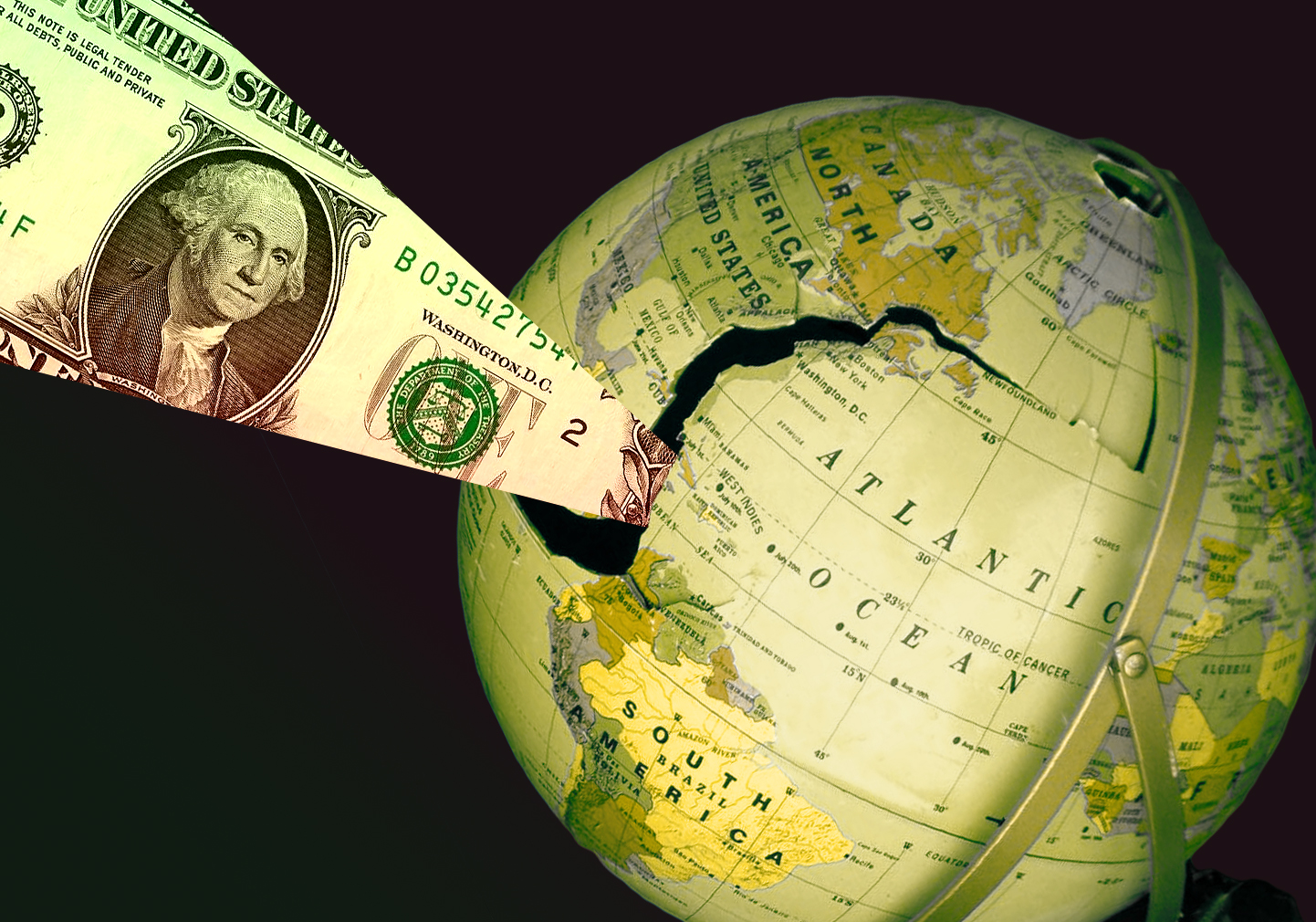
Protectionist tendencies have been present worldwide for some time already. It was expressed most glaringly in the rise of Donald Trump and his “Make America Great Again” and in the Brexit vote in 2016. The more far-sighted bourgeois watched in horror at the rise of the right-wing populists talking about a more aggressive stance against trading partners and breaking the so-called “rules-based order.”
But now, it is not just right-wing populists that are in favour of protectionism. The liberals, the typical defenders of free trade, have moved towards protectionism in words and deeds. U.S. president Joe Biden passed his badly misnamed Inflation Reduction Act which provides incentives for companies to produce their electric vehicles with critical minerals from North America or U.S. allies. Emmanuel Macron, French president and poster boy of liberalism, has called for a “Buy European Act”.
Here in Canada, the Liberal government has also been pulled in this direction. Finance minister Chrystia Freeland has been talking about “friend-shoring”, a euphemism for applying protectionist measures against countries that are not our “friends”. The first target of this approach is China.
The Canadian government recently ordered three Canadian lithium mining corporations in Chile and Argentina to cut ties with their Chinese investors. Another measure aimed at China is the prohibition of state-owned companies investing in Canada’s “critical minerals” sector. After massively increasing trade with China in the 1990s, Canada is now following the lead of the U.S. by taking more protectionist measures. Policy towards China is getting more and more hostile and Freeland has labelled the country an “increasingly disruptive global power.”
Some Canadian capitalists are keenly aware of the dangers of trying to “decouple” the Canadian economy from the Chinese economy, and fear for the stability of the system. Dennis Darby, president and CEO of Canadian Manufacturers & Exporters, commented thus: “I’ve never seen a transition like this. Every company is trying to figure out where the puck is going.” He adds: “We have relied on China and Southeast Asia manufacturing [for decades],” he says. “They’re not going anywhere. You don’t suddenly stop.”
Once protectionism starts, it is difficult to predict where it ends. Tariffs invite more tariffs in a tit-for-tat escalation. In the 1930s, protectionist measures contributed in transforming the market crash of 1929 into a deep decade-long Depression. Today, the ruling class in Canada, the U.S. and across the world is moving to end free trade as we know it. The most far-sighted bourgeois know this is a dangerous game, but have nothing else to offer.
Protectionism will make inflation worse as goods produced less efficiently at home replace cheaper foreign goods. At the same time, what was previously affordable for the average worker could become a luxury. It will also disrupt companies’ supply chains, which could slow or halt production in some industries and thus accelerate the recession, which almost everyone agrees will hit in 2023.
Recession
In previous documents we have explained how the key issue in this crisis, just like all other crises, is “who pays?” This question has been the motor force of the majority of revolutions in human history—including the French Revolution. The capitalists have been twisting and turning trying to avoid the repercussions of the crisis. But in the final analysis it cannot be avoided.
However, the ruling class can evade the symptoms of the crisis temporarily, but only by converting the crisis into a different form. This was explained by Marx in the Communist Manifesto, who said, “How does the bourgeoisie get over these crises?… by paving the way for more extensive and more destructive crises, and by diminishing the means whereby crises are prevented.” No matter how the bourgeois twists and turns they cannot evade the question of who pays and the class struggle.
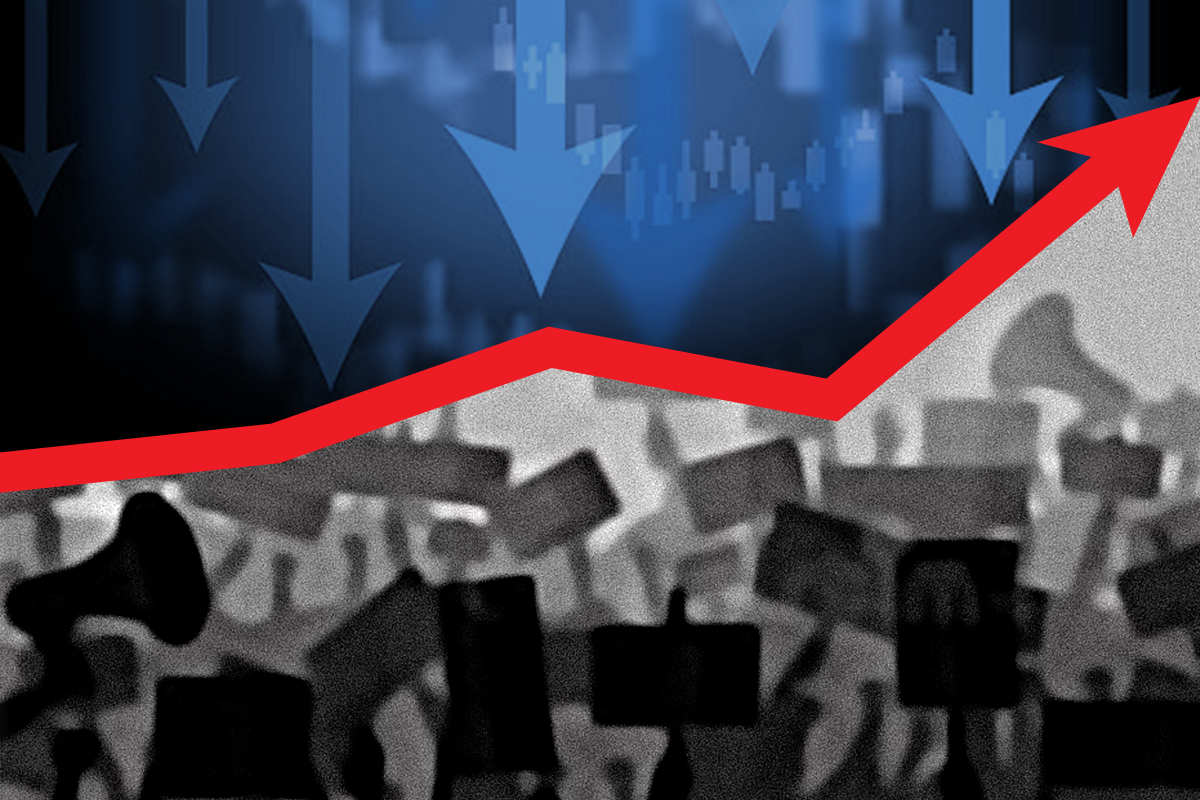
In order to escape the consequences of the crisis of overproduction, which has become an organic crisis of capitalism, the bosses resorted to massive state expenditure, quantitative easing, and debt. This stopped there being a deflationary spiral as seen in 1929-1933 when thousands of banks and corporations went bankrupt and unemployment skyrocketed. But the result of this expenditure is inflation. So instead of the workers paying via unemployment, the workers are paying via high prices. One way or another the crisis cannot be avoided – it is a case of out of the frying pan, into the fire.
However, having taken measures to superficially avoid and delay the symptoms of crisis, the bourgeois have inserted a whole series of exacerbating factors. In addition to inflation, there is a massive burden of accumulated debt. The ratio of debt to GDP almost doubled between 2007 and 2022. Currently, consolidated public debt stands at approximately $3-trillion. Previously, reformist economists informed us that debt was not a problem, as low interest rates lowered debt repayments. The Marxists calmly informed them that debt and deficit will cause inflation, which will result in increased interest rates and ballooning debt servicing costs. Again, the Marxists have been proved 100 per cent correct.
Interest on government debt has increased significantly from being approximately one per cent of GDP in March 2021 ($24-billion), to 2.6 per cent in March 2022, eating up seven per cent of government revenues. Since then, interest rates have increased from 0.25 per cent to 4.5 per cent. Every one per cent increase in interest rates leads to an extra $10-billion in payments for the federal government, and a similar figure for the provinces. Canada already stands as the 20th most indebted country on the planet, with a gross debt to GDP ratio of 112.9 per cent. This is not quite as bad as the USA (128.1 per cent) and Italy (150.9 per cent), but is worse than the UK (95.3 per cent) and Sri Lanka (103.1 per cent) both of which are facing an economic and political crisis.
To make matters worse, most economists believe that increased interest rates will cut off investment and curb demand sufficiently to lead to a global recession in 2023. And Canada will not be excluded from these developments. Things are already heading down. Growth in Canada was a mere 0.1 per cent in October 2022, GDP stalled in November, and shrank by 0.1 per cent in December.
While inflation has stopped increasing, there is no guarantee that it will be back to typical levels when this recession hits. Inflation has been particularly persistent in food and housing. Therefore workers will face the double whammy of increased unemployment together with increased costs of essentials.
Stagflation combined with rising debt payments due to high interest rates is a real prospect for working class families. Canadian households now owe an historically high $1.83 for every dollar of personal income. In the second quarter of 2022 this amounted to 13.5 percent of family budgets but it increased to 14 percent in the third quarter. At this rate an increasing fraction of family income will be taken up by mortgage and credit card payments.
The effect of the increased debt payments is increased bankruptcies. Figures have already shown that personal bankruptcies have been moving upwards. For the third quarter of 2022, they were up 22.5 per cent compared to the same period the year prior. This is only going to get worse as people lose their jobs in the recession. This in turn will impact the housing market which has been a major driver of jobs and economic activity over the last decade. The housing market is predicted to drop from its peak by 30 per cent by the middle of 2023 due to increased interest rates and therefore more expensive mortgages. But personal bankruptcies could have the effect of decisively bursting the housing bubble that has built up. Bankrupt families will be forced to sell their houses at a discounted price. Cause becomes effect and effect becomes cause with the possibility of a downward spiral of bankruptcies and housing prices falling, leading to further job losses, more bankruptcies, and so on.
On the governmental front, any recession will worsen the debt to GDP ratio and also cut the revenue needed to finance interest payments. The knee-jerk reaction to such a situation is to slash spending to balance the budget. But it is not guaranteed that such a policy of austerity will work economically, as countries like Greece show that cuts often reduce GDP faster than they cut debt.
Despite this, the consensus is to turn away from “stimulus” measures and deficits in favour of balanced budgets to manage the growing debt. Finance minister Chrystia Freeland warned that she was going to take a “fiscally prudent approach”, which is code for cuts and balanced budgets. The spectre of austerity and service cuts looms over the working class. If previously it was out of the frying pan, into the fire, now Canada traverses from the fire into the deep freeze. The effect this will all have on class consciousness cannot be overestimated.
The purpose of the above analysis is not to predict every single movement in the economy, and every reaction by the ruling class in fiscal and monetary policy. The capitalist class can choose to pursue an inflationary policy of low interest rates and deficits, or a deflationary policy of high interest rates and austerity. The point of perspectives is to show that every move they make will be wrong, because the crisis is not based on this or that governmental measure but on the failure of private production for profit that cannot develop the means of production.
Whether the capitalists choose a deflationary or inflationary policy the end result is the same—the working class will pay. High prices of essentials due to inflation. Unemployment due to recession and public sector job cuts. Poorer services due to austerity. Increased debt payments and bankruptcies due to high interest rates. All of these factors bear down on the population. For the working class, the contradictions of the system can only be resolved through class struggle.
Psychological effects of the crisis
If anything can be said about human psychology is that it is inherently conservative. People don’t like change. For working class people, change almost always means bad things. They look back to a supposed better past with rose-tinted glasses. Consciousness lags behind objective reality. Ironically, it is this conservatism of human consciousness that creates the necessity for revolution. And eventually, consciousness catches up to reality with a bang.

Increasingly, the population is coming to understand that the current crisis is not a temporary aberration. Anybody under the age of 30 has spent their entire adult life in conditions of social, economic, and environmental crisis. This has massive effects on psychology.
In the period after the second world war, the working class in the advanced capitalist countries became used to reforms and steady improvement. Class relations were softened and class consciousness was also softened. This contrasts sharply with the period of 1917 to 1939 where the working class was hardened by the experience of war, depression, revolution and counter-revolution. Canada, having achieved many reforms in the post-war period, was one of the countries where illusions in reformist progress under capitalism were the most pronounced.
But now, increasingly, mass psychology is catching up with events and more and more are developing the outlook of the 1930s. In the first stages, this change in psychology manifests itself as polarization. The liberal “middle” is increasingly untenable as people look to anti-establishment solutions to the crisis.
Polarization, by its nature, means a collapse of the middle and a concentration of forces to both the right and the left. There have been a number of expressions of right polarization. This process was expressed in the five per cent vote of Maxime Bernier’s People’s Party of Canada in the 2021 election, and then in the 30 per cent support for the antivax Freedom Convoy in February 2022, and now with the rise of right populist Pierre Poilievre in the Conservative Party.
Significantly, while young people traditionally vote NDP, recent polls have placed Poilievre as the most popular politician among young men. According to an Angus Reid poll from last September, Poilievre would get the vote of 48 per cent of 18-34 year old men. This switch in support is due to the moderation and bankruptcy of the NDP leadership, which leads young men to find an alternative to the status quo in a very confused way through Poilievre. Thankfully only 23 per cent of young women support the Conservative leader, which shows the better class instincts of this oppressed group.
However, as we have repeatedly said, polarization is not equally balanced. The preponderance of anti-establishment sentiments is to the left and not the right, especially among the youth. This has been shown in a number of polls that reveal progressive opinions. The idea of increasing taxes on the rich routinely scores an extreme majority in the polls—one conducted in October finding that 80 percent of Canadians support such a measure.
One million communist youth in Canada
Ironically, the clearest example of left wing polarization is shown in a poll conducted by the Fraser Institute, of all people. The Fraser Institute is a right-wing libertarian think tank which has no interest whatsoever in amplifying the support for socialism and communism. However the results of their poll do precisely this.
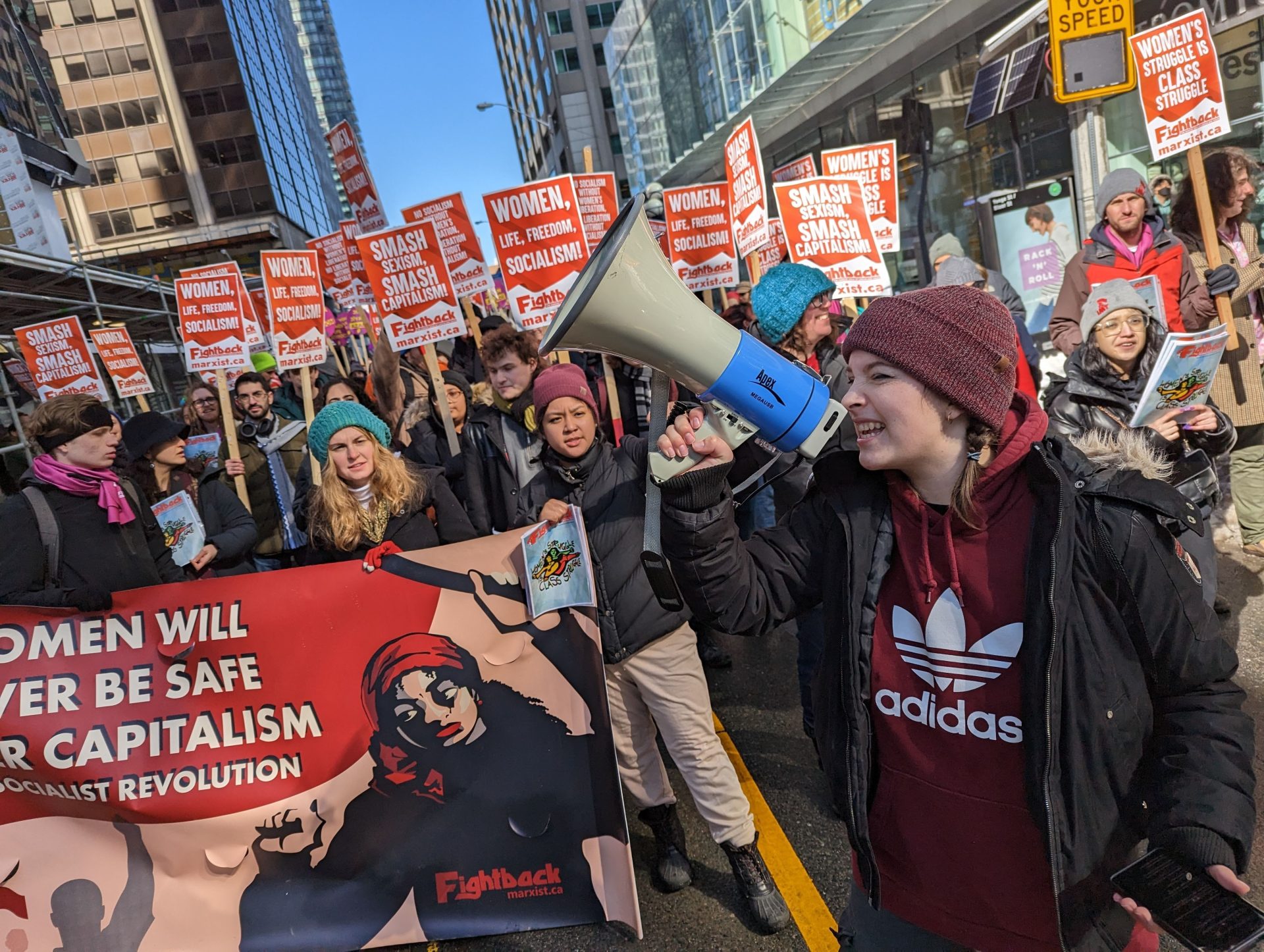
The poll found that among the 18-34 year olds, 13 per cent agree that communism is the ideal economic system. If we keep only the 18-24 year olds, the figure is at 17 per cent. These figures mean that over one million young people in Canada support communism as the ideal economic system!
Meanwhile, the support for socialism is par for the course at 50 per cent among the youth. This is less than a poll conducted in 2019 which said that 58 per cent of Canadians had a positive view of socialism. While the interest for “socialism” seems to be stagnating, there is now a significant constituency that considers communism as the way forward.
We cannot overstate the symptomatic significance of such a survey. What is even more astounding is when you think about the fact that there is no serious and well-established political force arguing in favour of communism or socialism. Both the NDP bureaucracy and the Québec solidaire leadership studiously avoid the “S-word”, to say nothing of communism. Imagine what these numbers would be if there was a mass communist organization in existence in Canada!
The Fraser Institute polls did not stop at Canada. When it comes to communism, it also found that 20 per cent of the youth in the United States support it as an ideal system, whereas this number jumps to 29 per cent for the youth in Britain.
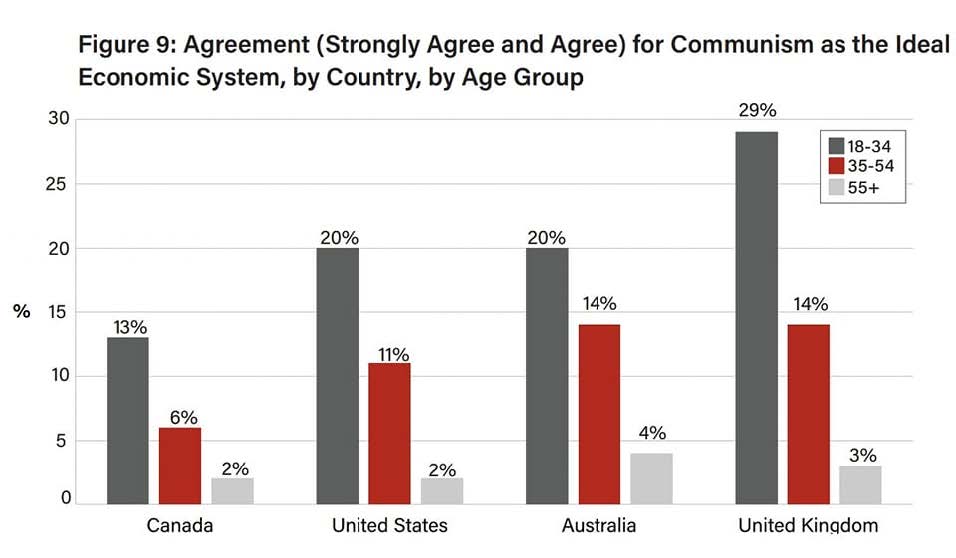
In many ways, this can be considered very accurate empirical evidence of the state of class consciousness in these three countries. The crisis of capitalism is especially acute in Britain, where the country is in complete disarray with a sharp decline in living standards since the 2008 crisis in particular, now compounded by more than 10 per cent inflation, and a hated Conservative government constantly attacking the workers and youth. The United States is not far behind. But Canada, as we have pointed out already, avoided the depths of the 2008 crisis. Austerity in Canada was milder, and while living standards are indeed declining, they are doing so from a higher starting point. The stage of the crisis is very well reflected in this differing support for communism in the three countries.
What we can say is that the chaos in Britain and the political crises in the United States and their impact on consciousness show us our future here in Canada. As the crisis deepens, more and more youth will be moving towards communism.
The youth today is nothing like the previous generations. For anyone in their mid-30s and younger, all they have known during their conscious life is a capitalism in near constant crisis. They have been awakened to politics to one degree or another in a period comprising the 2008 crisis and the austerity that followed; terrorism; Donald Trump and his imitators in other countries; the COVID crisis; housing prices through the roof; and an environmental catastrophe unfolding before our very eyes. The youth has seen next to no reforms in their entire adult life. How can this not eventually lead these people towards a radical, socialist or communist alternative?
Mos maiorum
Historians of Antiquity cite an important factor in the collapse of the Roman Republic. In addition to all the explicit rules of the Republic, there were also unwritten rules that ensured the stability of the system. These unwritten rules were known as “mos maiorum”, which roughly translates as “ancestral customs”. These customs between the various political parties kept political struggle within certain bounds so the system as a whole was preserved. In the later crisis of the Republic, the political actors increasingly violated these unwritten laws, contributing to the downfall of the entire edifice.

Violation of the modern mos maiorum is a feature of all the main bourgeois “democracies”. We saw it with Trump who ignored all the decorum of the U.S. presidency, refused to recognize the results of the 2020 election and whose supporters staged a riot on Capitol Hill. In Brazil, the right-wing populist Bolsonaro mimics Trump as best he can. In Britain, the most rabid wing of the Conservative party succeeded in winning the Brexit vote and pushed for a “hard” exit from the European Union. These people have violated all the norms of politics and pushed them to the limit.
Canada is not immune to these increasing violations of political norms. This was noted by one of the most serious bourgeois newspapers in existence, The Economist. In an article titled “A ticking bomb under Canada’s constitution”, it explained the danger with the existence and the increasing use of the “notwithstanding clause”. This gives federal parliament or provincial legislatures the power to override rights protected in the Canadian Charter of Rights and Freedoms such as freedom of expression, freedom of association, freedom from unreasonable search and seizure, the right to peaceful assembly, etc.
The Economist commented thus:
“Canada has yet to produce a Donald Trump, but it may have weaker constitutional defences than the United States if such a person appears. Section 33 [the notwithstanding clause] ‘creates a vulnerability to the democratic backsliding that is occurring elsewhere’…”
In another related article, they explained that “it is naive to assume that a constitutional loophole will not be abused in defiance of fundamental freedoms.” The normalization of what was supposed to be an exceptional nuclear option worries the most farsighted defenders of capitalism.
Justin Trudeau also expressed his concerns when Ontario Premier Doug Ford attempted to crush the education workers’ strike by using the notwithstanding clause to secure back-to-work legislation. He complained that “Canadians themselves should be extremely worried about the increased commonality of provincial governments using the notwithstanding clause preemptively to suspend their fundamental rights and freedoms,” adding that “The Charter of Rights and Freedoms cannot become a suggestion. The outrage we’re seeing across the country right now … I think, is a moment for all Canadians to reflect.”
Former Conservative leader Erin O’Toole, who was ousted by a revolt during the Freedom Convoy, expressed similar sentiments and raised the concerns of Bay Street against undue partisanship and the erosion of Canada’s supposed democratic traditions. Criticizing the “F*** Trudeau” flags appearing more and more in Conservative demonstrations and events, O’Toole explained:
“Mr. Trudeau was my political opponent not my enemy. These flags and the hyper-aggressive rhetoric that often accompanies them are slowly normalizing rage and damaging our democracy.”
He added:
“The proliferation of these types of political displays in recent years are a sign that we are slowly becoming desensitized to political stunts and aggressive rhetoric whether it comes from the left or right. In fact, the extremes appear to be playing off one another as they frame the debate around the motivations of political leaders.”
O’Toole adds that “This tone of division and mistrust is slowly becoming the new normal in politics.” But O’Toole offers no clear solution as to what can be done to bring back the “political debate” within the confines of the norms of bourgeois democracy.
The notable violations of unwritten rules is the wanton use of the notwithstanding clause, the routine use of back-to-work legislation, and moves by the western provinces to not recognize the authority of the Federal government and the Federal courts. In and of themselves, the more intelligent bourgeois do not oppose the right-wing policies implemented by violating the rules. What they are concerned about is that the workers will see through the hypocrisy and think that the rules don’t apply to them either. If the notwithstanding clause can be used to impose policies on the workers, why couldn’t it be used to impose policies against the bosses?
In the West, the provincial governments of Alberta and Saskatchewan are on a constitutional collision course with the federal government on the question of jurisdiction over environmental regulations, greenhouse gas emissions, and carbon taxes that will have an impact on the oil and gas industry. Alberta premier Daniel Smith passed the Alberta Sovereignty Within a United Canada Act in the provincial legislature in early December of last year. This will give the Smith government the power to overrule the courts and defy “any federal initiative.”
Premier Scott Moe’s Saskatchewan Party is also in the process of passing similar legislation in that province, the Saskatchewan First Act. With the Saskatchewan First Act, in effect, the Saskatchewan Party, and not the courts, will decide what is constitutional or not when it comes to natural resources and the oil and gas industry in Saskatchewan. Both the Saskatchewan and Alberta governments are putting to test the viability of the Canadian confederation.
In Quebec, Legault’s CAQ government has invoked the clause twice in recent years. It used the notwithstanding clause when it passed Bill 21 banning religious symbols for public servants and again in 2022 when it passed Bill 96 on the use of French in the public services and schools. Legault is clearly harking back to the nostalgic populism of Maurice Duplessis in order to whip up “national unity” to cut across the class struggle.
While the Canadian Confederation is not about to collapse imminently, it is slowly being eroded under the pressure of the capitalist crisis. As The Economist said, all of these things are “a ticking time bomb in Canada’s constitution”. These right populist forces are actively sawing off the branch of bourgeois legality they are sitting on. They are playing with fire and contributing to the discrediting of the system in the eyes of the working class.
The Constitution and the courts are bourgeois institutions by definition and were created precisely to defend the bourgeois order and ensure the rule of the capitalists. The revolutionary struggle of the working class to change society will not be successful if it remains within the legal confines of the society it is trying to overthrow. What’s more, upon coming to power the working class will have to completely overturn these structures and laws, and create new revolutionary structures and institutions, ushering in the socialist transformation of society.
It is not the task of the working class to solve the constitutional problems of Confederation. The historic task of the working class is to overthrow capitalism. The bourgeois constitution and Confederation of Canada will be replaced by a society of workers’ democracy – a far higher form of democracy.
The spectre of a Poilievre government
The failure of the NDP to offer an anti-establishment alternative raises the spectre of a right populist government under Pierre Poilievre. While we’ve said that polarization skews left, the absence of an organized expression on the left gives an electoral advantage to the right-wing. The right populists are unapologetic and therefore much better organized than the left who are afraid of their own shadow and are tied to the liberal status quo. The knuckle dragging leadership of the Freedom Convoy had the virtue of being bold in their ideas and actions. And while not being quite as crass, Poilievre also taps into the same anger.
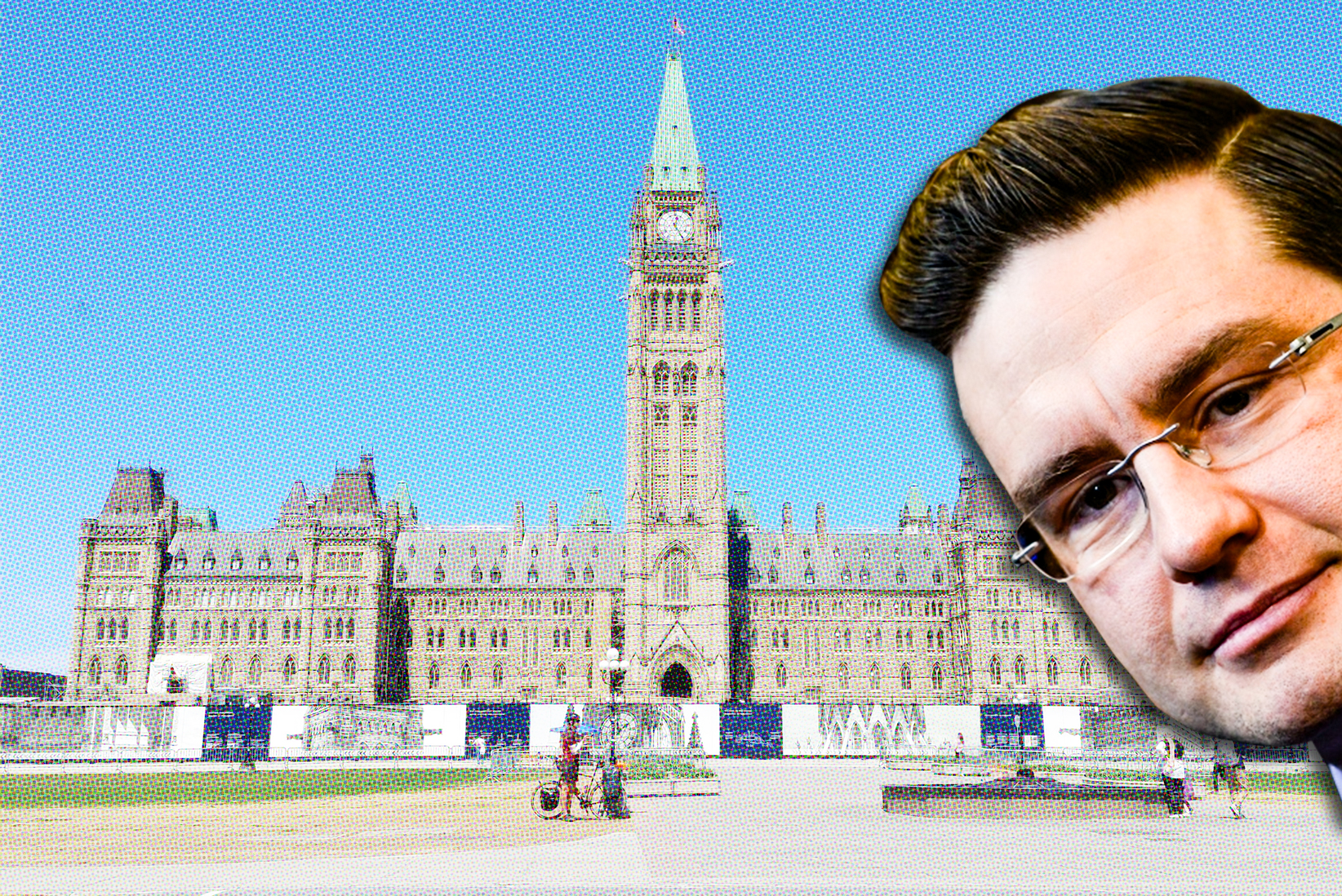
Poilievre rails against the “financial elite,” saying that “everything feels broken” and relentlessly criticizes the Trudeau government for impoverishing the “working class.” He went as far as denouncing “a small financial elite with access to all of that printed money, buy up real estate and rent out to a growing class of permanent tenants; people who may never be able to afford a home.” His main criticism of the Trudeau government is its financial policy which has led to what he calls “Justinflation.” And this rhetoric is starting to have an effect with a number of polls putting the Conservatives ahead of the Liberals.
Poilievre has also been capitalizing on the NDP tying itself to the Liberals. This was clearly seen when, back in April 2022, NDP leader Jagmeet Singh tweeted that “Under a Liberal and Conservative system—rigged in favour of the rich—inequality has grown in the pandemic.” Poilievre responded: “Yes the ‘system’ is rigged for rich but you ARE the system Jagmeet. Your coalition’s policies inflate wealth of rich & living costs of the rest. You crush the working class NDP used to champion. Own it or end your coalition now.”
The next federal election isn’t scheduled until October 2025. However, as we currently have a minority government, an election could be triggered before this time. With a tired minority government, propped up by the NDP, with the Conservatives rising in the polls, the prospects of a Poilievre government is real.
The labour movement and the left in Canada must learn the lessons of Donald Trump’s electoral victory in the United States in 2016. What Marxists explained at the time was that the ticket to Trump’s success was that he was able to tap into an anti-establishment mood which developed as the capitalist system was increasingly ruining people’s lives. After two terms of an Obama presidency which oversaw declining living conditions there was a growing sense of anger against the Democratic Party and the capitalist establishment in general. Trump demagogically used populist rhetoric against “the system,” Wall Street and the Democrats, and even spoke about protecting the “working class.”
In Canada we are facing a very similar situation. After initially riding a wave of anti-Conservative anger, Justin Trudeau has been in power for nearly six years and the “sunny ways” have been replaced with dark clouds overhead.
The economic situation is not rosy to say the least and inflation is pushing more and more Canadians to rely on food banks. The charity Second Harvest expects that food bank visits should climb to 8 million per month in 2023. In addition to this, people are growing increasingly tired of the use of performative identity politics which only mask the real policies of the Liberal government. The latest example is the talk of appointing an Indigenous head of the RCMP—as if this will change the nature of this horribly racist and oppressive wing of the state.
We should be on guard against so-called lesser-evil type arguments which are bound to become more common. As the spectre of a Poilievre government becomes more and more clear, there will be alot of fear mongering engineered to drive people into the arms of the hated Liberals. We must reject this and point to the failed campaign of Hillary Clinton to demonstrate that you cannot defeat rightwing populism with Liberalism or establishment reformism for that matter. With the NDP being tied to the Liberals and no imminent prospect of that changing, Poilievre stands a good chance of riding the wave of anger and coming to power in the next election.
A Poilievre government would mark a qualitative shift away from the policies and approach of the Trudeau Liberals up to this point, which has been avoiding acute class struggle through using deficit spending. Poilievre is a libertarian who would seek to immediately balance the books through public sector layoffs, a generalized program of austerity, and war on the working class.
For a generation, the dynamic of Canadian politics has been very much focused on events occurring at the provincial level. The tempo of the class struggle has recently been quite uneven from province to province. One province can be on the verge of general strike while its neighbour is entirely peaceful! But a Poilievre government opens up the stage for putting federal politics front and centre. A Canada-wide struggle against Conservative austerity becomes a real prospect. Such a thing happened under the Pierre-Elliott Trudeau Liberals, when they implemented the hated policy of wage and price controls. This triggered a one day general strike in 1976 in which 1.2 million Canadian workers participated. We cannot exclude a similar scenario under the vicious austerity that a Poilievre government would put forward.
However, it is of course possible that the Liberals win the next election. It is generally dangerous to try and definitively predict elections. But a fourth victory for Trudeau in no way means a continuation of the policy of deficits and appeasement of the working class. With the growing burden of debt servicing, the Liberals in power are sure to also engage in a policy of austerity. We only need to remember that the worst federal austerity program in Canadian history was under the Liberal government of Jean Chretien in the 1990s. Whichever of the Liberals or Conservatives win the next election, what is on the agenda is austerity, and the class struggle that will flow from it.
Irrelevant NDP
In the process of crisis, mass polarization, discrediting of the capitalist institutions and rise of socialist and communist consciousness among the youth, the NDP has set itself up as the last line of defence of the status quo. In the press release announcing their deal with the Liberals, the NDP wrote the following: “Politics is supposed to be adversarial, but no one benefits when increasing polarization and parliamentary dysfunction stand in the way of delivering these results for Canadians.” The NDP standing in the way of polarization reminds us of the legend of King Canute who attempted to order the tide to halt, and it is sure to be just as successful.
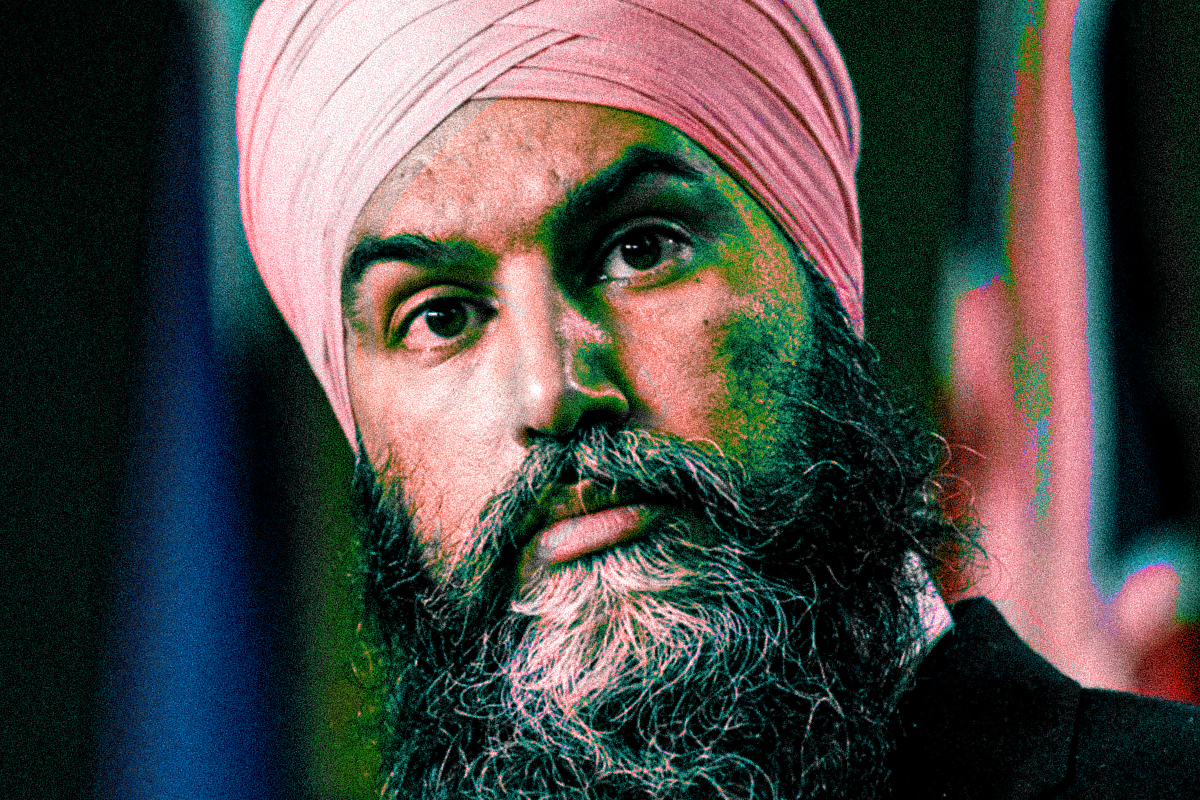
The worst expression of their defence of bourgeois normality is their “confidence and supply” agreement with the Trudeau Liberals. This deal is supposed to last until 2025 and it represents a complete capitulation of the party for almost nothing in return. The deal was based on vague promises related to dental care, pharma care, anti-scab legislation, housing, long-term care, and an excess profit tax. But it is clear that the Liberals have no intention of implementing any substantive programs, and are instead just giving temporary cash handouts. The NDP in its turn is doing its best to present their miserable submission as some sort of victory. But with the turn to balanced budgets and austerity, this shaky deal will be stretched to the limit.
It is difficult to overstate how little the NDP is getting out of this. The $500 “targeted support for households” only applies to families making less than $35,000 net a year, or $20,000 for individual renters.
The dental plan, which was supposed to be the main achievement of the deal, amounts to a $650 handout to cover dental costs for children under 12 for families making less than $90,000 who are without dental insurance. This is supposed to be extended to 13-18 year olds, seniors and disabled people by 2025 – by which time the Liberals will have likely turned to austerity, if they are still in power at all. Families will have to apply through the Canada Revenue Agency to get their hands on this money. With a state bureaucracy incapable of the prompt delivery of passports, unemployment insurance cheques or timely processing of immigration applications, there is no doubt that many people will be deterred by the potential bureaucratic nightmare. Most importantly, the fact that it is a special cash handout and not a real program makes it much less cost effective and very easy for future governments to cancel.
The NDP has tied itself to the status quo for a few crumbs the Liberals probably would have implemented without NDP support anyway.
In January, NDP leader Jagmeet Singh suggested that if the Liberals didn’t table a pharmacare bill this year, that it would be a “deal-breaker.” The agreement between the two parties says that a bill calling for a “National Drug Agency” to “develop a national formulary of essential medicines and bulk purchasing plan by the end of the agreement” has to be tabled by the end of 2023. But this commitment is so vague and that the Liberals may well be able to fulfill it while imposing budget restraint. The NDP would find itself supporting the Liberal turn to austerity in exchange for another empty commitment.
The NDP is faced with a ridiculous choice. They either continue propping up the Liberals and being responsible for their coming turn towards balanced budgets and austerity, or they bring down the government raising the question of what changed between now and then. No one would understand why they supported them in the first place in return for nothing. In the election, no one will feel the need to vote NDP, because you get Liberals anyway.
One can see the dynamic of the next election with Poilievre concentrating the protest vote against the status quo, while the Liberals concentrate the vote in favour of the establishment. In this equation, what is the point of the NDP? And most importantly for Marxists, why would any radicalized worker or young person ever decide to join the party?
The “Not Democratic Party”
The NDP’s defence of the Liberal status quo is combined with a crackdown on any left-wing voices amongst the membership. This puts a big question mark over the future of the party.
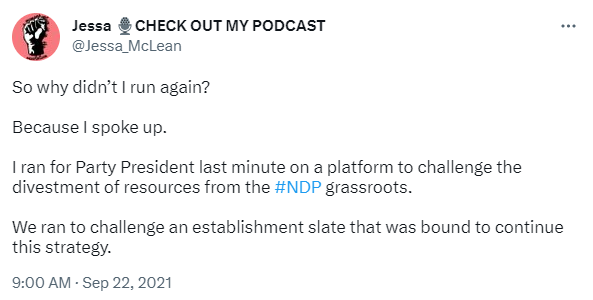
The most glaring example of this is what happened in the B.C. NDP in the fall of 2022. With Premier and NDP leader John Horgan stepping down, a leadership race was triggered where Anjali Appadurai, a climate activist who had been critical of the NDP government, ran on a platform of progressive reforms, similar to Jeremy Corbyn or Bernie Sanders. Her campaign was described by the media as an “insurgent” campaign and was seen as a left-wing opposition to the Horgan-Eby clique. But in a scandalous anti-democratic move, she was disqualified from running in the leadership race on the most dubious charges.
The reason for her disqualification was clear. The party membership had fallen by almost half during John Horgan’s tenure as premier, down to 11,000. Appadurai was reported to have signed up between 10,000 and 14,000 new members, while the establishment candidate David Eby had signed up only 6,000. She most likely would have won, and the NDP bureaucracy could not let that happen. Scandalously, it was revealed that the NDP tops sought the help of Canadian Labour Congress bureaucrats to help them fight against Appadurai!
In the end, they got what they wanted with Eby being crowned as NDP leader and premier without the inconvenience of anybody having a vote. Eby has made it very clear that he has no intention of breaking with the status quo in any way stating: “British Columbians shouldn’t expect any radical departures if I’m successful.”
Fortunately for the capitalists and landlords in the province, the B.C. NDP bureaucracy successfully crushed the left-wing “insurgency”, and now presides over the worst housing crisis in the history of the province, among other things. While Appadurai has said she would stay in the NDP and appealed for supporters to “fight inside” the party, we can safely assume that the thousands who were enthused by her campaign have probably left in disgust.
In Ontario, the ONDP bureaucracy did everything they could to sideline and discredit Jessa McLean, a former candidate and open socialist organizer. McLean had also run for the party president position, getting 30% of the vote. The bureaucracy refused to recognize her repeat candidacy and then parachuted a candidate in her riding, ignoring the right of party members to choose their own candidate. Then, she was smeared and expelled by the bureaucracy for alleged antisemitism and harassment for merely criticizing the party leadership.
On a federal level, left-wing MP Niki Ashton was sidelined and removed from all caucus positions in 2021 with the bureaucracy using the pretext of her trip to Greece to visit her sick grandmother during lockdown. When accused of non-existent antisemitism for holding an event with ex-Labour Party leader Jeremy Corbyn, the NDP bureaucracy did nothing to defend her. In fact, the NDP tops have been actively sidelining pro-Palestinian candidates for years, falling for the smear that any criticism of the Israeli state is antisemitism.
The leadership of the NDP, both on a federal and provincial level, seems to have learned a thing or two from the British Labour Party. There, Jeremy Corbyn won the party leadership in 2015 as an avowed socialist, taking the right-wing party bureaucracy completely by surprise. It took four years of slander, lies and backstabbing by the right wing of the party to finally get rid of him. The new party leader, Keir Starmer, has since been on a war against the left-wing, expelling socialists and announcing that Corbyn would never be allowed to stand again. While things haven’t heated up to such an extent inside the NDP, the Appadurai disqualification shows that the NDP has learnt that democracy is too dangerous and therefore they will not let any left-wing, socialist or anti-establishment figure even run. So much for the “democratic” part of the New Democratic Party. We may add that the NDP isn’t particularly new and nobody there is having a party!
The result is that at a time when interest in socialism and even communism has never been higher, especially among the youth, the NDP brass have been doing everything in their power to silence or purge the few remaining left-wingers and socialists in the membership. When they should be fighting the establishment, denouncing capitalism and mobilizing the youth and workers, they instead only seem to be interested in clamping down on socialists and cozying up with the Trudeau liberals. Even if young people wanted to join or get active, there is nothing for them – no meetings, no youth conventions, nothing. Unsurprisingly, there is zero enthusiasm for the NDP.
The disconnect has even spread to union workers, the traditional base of the party. Recent polls have shown that a trade union member is really no more likely than the general population to vote for the NDP. One poll showed that among public sector unionized workers, the NDP would get 26 per cent of the vote, second to the Conservatives with 34 per cent. Among the private sector unionized workers, the voting intentions are at an abysmal 14%, far behind both the Conservatives and Liberals!
Dead end of reformism
Another example of the bankruptcy of the NDP leadership is in foreign policy where they have moved far to the right.
This is clear when one looks at their stance on Canadian involvement in the war in Ukraine. In the past, the NDP was seen as the anti-war party and had a pacifist critique of imperialist adventures abroad. In the 1980s for example, the NDP demanded that Canada pull out of NATO and former party leader Jack Layton was critical enough of the 2001 war in Afghanistan to be dubbed “Taliban Jack” by the Conservatives.
These days, the NDP bureaucracy has thrown any anti-war rhetoric out the window and has jumped on the imperialist bandwagon. When the Trudeau government announced that they were spending $70 billion on new fighter jets, the only criticism the NDP offered was that the Liberals weren’t getting the best deal possible, and that the weaponry should be made in Canada to protect Canadian jobs for defence contracts! You cannot make this stuff up.
On the provincial level, the NDP has been just as bad, and this is clearly seen in Alberta and British Columbia.
In Alberta, despite the crisis of the UCP government and the downfall of Jason Kenney, the Alberta NDP cannot garner any enthusiasm. Polls are consistently neck-and-neck, and the right populist Danielle Smith could very well win the 2023 election. This is because on fundamental issues, the NDP doesn’t say anything different.
Rachel Notley has taken nearly identical positions to her rightwing counterpart on key political issues. For example, on the Federal government’s just transition program, Notley and Smith competed for the title of “fiercest advocate of the oil industry”. Notley did oppose the Alberta Sovereignty Act, but not because it was a reactionary project attempting to whip up western alienation and divert anger against Ottawa. Her main problem with the sovereignty act was that it would be bad for business! All of the NDP’s arguments focused on how bad it would be for investment. In preparation for the provincial election, Notley’s campaign was launched at the Calgary Chamber of Commerce. They are busy trying to convince the oil barons that they can be more reliable partners who can better manage capitalism than the UCP. They believe that moderation and compromise is the way forward. Notley even thanked Jason Kenney for his “service” after his resignation!
The only example of the reformists in power currently is the BC NDP. The list of betrayals of this government is long and deplorable: from the crackdown on the Wet’suwet’en First Nation, to breaking promises on old growth logging, to the failure to build public housing to solve the housing crisis, to the attack on the BCGEU public sector workers.
The reason the reformists are so disappointing is that they are following the logic of refusing to break with capitalism. In this epoch of capitalist crisis, reformism is untenable, and destroys its own base. This is reformism that only brings counter reforms. It is not because of the good or ill intentions and sentiments of the reformist leaders. It is merely the logical consequence of their policy. This is what we mean when we say that betrayal is inherent in reformism.
A similar process is beginning in Québec’s reformist party, Québec solidaire. The party has consolidated itself as a recognized constituent part of the political landscape with 12 MNAs after winning the March 2023 by-election in Montreal.

Unfortunately, the leadership of QS is moving in an increasingly moderate direction. Instead of presenting itself as a clear anti-establishment, anti-capitalist alternative, they continually try to collaborate with the CAQ in parliament. In order to appear more “reasonable”, they have renounced their long-standing position in favour of free education, saying this cannot be achieved in a first mandate. Their environmental proposals are now market-based; liberal cap and trade and carbon taxes. During the election campaign, their proposal to fight inflation by minor sales tax cuts were almost identical to those of the Liberals and the PQ. As a result, the party has stagnated and even lost votes compared to 2018.
Combined with this moderation, the QS has been incapable of fighting the right-wing reactionary nationalism of the CAQ. As left-wing nationalists, they constantly make concessions to the right – QS seems to believe that the CAQ and PQ electoral base is cemented behind the prejudices conveyed by these parties, and so the party constantly bends to supposedly win them over. They have not consistently fought the CAQ’s Bill 21. They also voted with the CAQ in favour of Bill 96, an update to the famous Bill 101, despite the fact that it imposes French services on immigrants after only six months and was clearly designed as a distraction and provocation against minorities. Faced with this process of moderation and concessions to nationalism, the left in QS has largely abandoned the fight. Dozens of activists have simply quit, while those who have stayed have next to no organized presence and opposition.
While QS is traveling on the same rightward path as the NDP, it is not quite as far down the road. However at the moment it seems unlikely that either party will be the expression of a movement of mass radicalization. Connected to the bankruptcy of the reformist organizations is the general cynicism towards electoral politics. This is also related to the general rejection of bourgeois institutions. It is highly unlikely the electoral sphere will be a centre of mass struggle in the short term.
Thus, when the class war is blocked on one area of the battlefield, it is forced to advance on different, more favourable terrain. The most likely centre of the class struggle in the next period will be extra-parliamentary, either on the industrial front or mass movements against oppression and the injustices of the capitalist system.
It is of course vital that we do not write off the political struggle, and even the parliamentary struggle. Eventually, the mass movement of the workers is almost certain to have a parliamentary expression. It is an inevitable stage of class conflict. But this is not a likely area of fight back in the short to medium term. Mass movements and mass strikes will arise and eventually, these movements will have their reflection on the political sphere. But this is two stages away from where we currently are, where the mass extra-parliamentary struggle has barely begun. It remains to be seen whether the class conflict in society will be reflected inside QS or the NDP, or in totally new political formations. We must follow the processes as they unfold, without any preconceived schema.
The industrial front
For the first time in a generation, there is an upturn in the class struggle in the workplaces. For decades, the labour bureaucracy has been able to put a lid on the union fight. But now, this absolute fetter on the movement is being beaten down so it is only a relative fetter. Important struggles are breaking out, such as the Ontario education workers, and the most corrupt representatives of the bureaucratic cliques at the top of the movement are being kicked out in favour of leaders who are very slightly to the left.
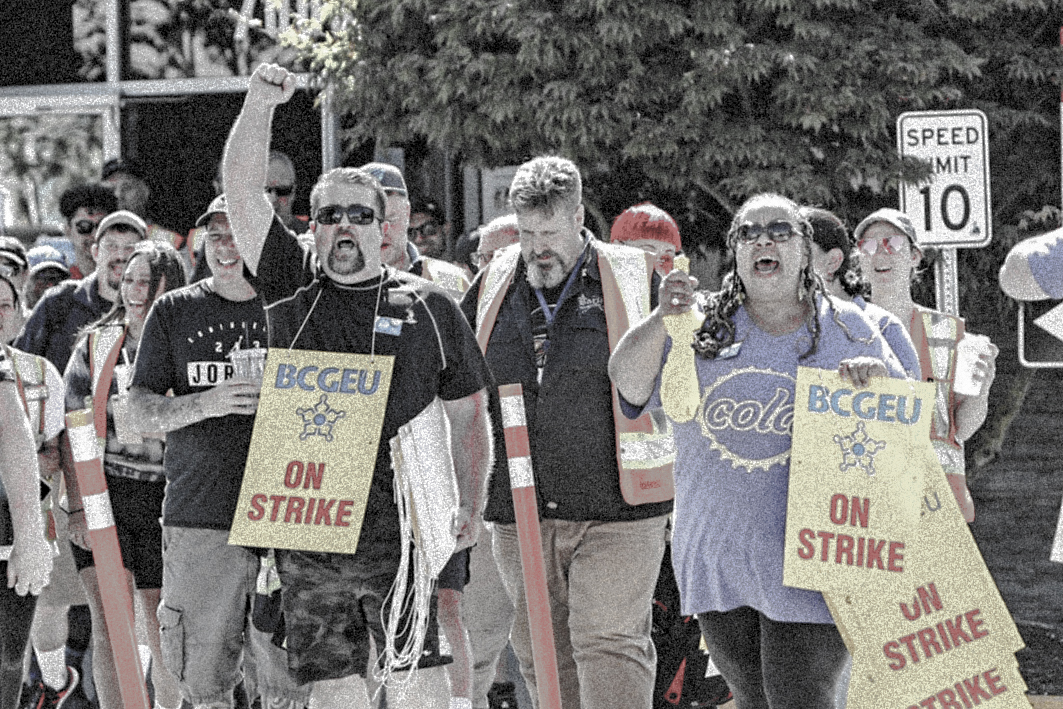
Strike statistics have begun to trend upwards. 2,155,612 person-days were lost due to strikes in 2022, the highest in over a decade and almost double the average for that period.
The reason for this rise in picketing is easy to determine. There is a general tendency for inflation to cause strikes. This is explicitly the main bargaining issue in the majority of the disputes that have occurred. As we explained earlier, in the last few years, wages have been lagging inflation by approximately 2 percent per year. This causes workers to demand that their standard of living is not further eroded.
In the previous period of low inflation, the labour bureaucracy could get away with selling zero and one percent contracts to their members because, as these were just a modest erosion, workers were not happy with it but didn’t feel they had any other option. But faced with six per cent inflation, workers will not swallow a one percent contract. Bureaucracies are therefore forced to fight or lose their jobs, to be replaced by other leaders who are more connected to the rank-and-file. Thus, we are seeing the beginnings of the rejuvenation of the labour movement from a very low level.
An example of this rejuvenation is the expulsion of the representatives of the most right-wing bureaucracies personified by the likes of Jerry Dias of Unifor, and Smokey Thomas in the Ontario Public Service Employees’ Union (OPSEU). These class traitors were some of the main proponents of “strategic voting” for the Liberals, before appearing on the same platform as Doug Ford. Unifor was also part of the Liberal negotiation team for the new version of the free trade NAFTA. It is significant that both of them were forced out after being complicit in corruption scandals involving millions of dollars.
Replacing the old right-wing, we’ve seen the rise of figures such as JP Hornick in OPSEU and Laura Walton in CUPE’s OSBCU, amongst others. The election of these figures represents the pressure from below. It is important that we realize that these leaders are not identical to the previous gangsterous dinosaurs of the right-wing, but we also do not have any illusions in these softest of the soft left reformists. Most of these new “left” leaders were a constituent part of the old right-wing bureaucracy. The difference is that unlike the right, they can be forced by the pressure from below to occasionally act.
Some in the movement have said that you must not criticize the left leaders. The reality is that if you remove the pressure on the left leaders, they will inevitably capitulate to the old right-wing bureaucracy. Therefore, to get anything good out of the “left”, it is vital to vociferously criticize any vacillations or backsliding they make, while also praising them for whenever they take a real step forward. Only by feeling the hot breath of militant workers demanding action will they be pushed to lead a fight.
The Ontario education workers’ strike
The 2022 Ontario education workers’ strike represents a turning point in the situation and is worthy of a detailed analysis. The 55,000 workers organized with CUPE managed to defeat the government’s back-to-work legislation and notwithstanding clause. This is an historic victory, the likes of which have not been seen in generations.
Over the last decades, only the Marxists said that it was possible to defeat back-to-work legislation via mass defiance and only the Marxists proposed escalating that defiance into a general strike. We were repeatedly told that this is impossible. The reality is that it is now very obvious that not only was it possible, but it is the only way for workers to win. Above all else, the education workers’ strike shows the massive power of the working class, if only it is unleashed and not held back by a corrupt bureaucracy.
As with most of recent struggles, the instigating issue was inflation. The Ontario education workers are in this sense no different from any other sector of the working class.
There has been some mythology created about how the “radical” left leadership of Laura Walton managed to mobilize these workers, but the reality is that this was quite limited. While it is true that Walton and co. in the OSBCU leadership had engaged in more rank-and-file organizing in preparation for the strike, this organizing was nothing particularly groundbreaking or revolutionary. However, giving the rank-and-file workers more room to voice their opinions and to mobilize without the bureaucracy clamping down at every turn was something entirely new for rank-and-file members in the union and galvanized the workers’ support for the strike. Although even this was patchy with very little done in the Toronto local CUPE 4400.
It also made the Walton leadership more susceptible to the mood of the rank-and-file workers. The workers were willing to fight—the strike vote was 96 per cent on an 83 per cent turn out. Determined to fight and refusing to back down, the workers were able to pressure Walton and co. to take the road of illegality. But the difference with other struggles was not so much the leadership mobilizing the workers, but the leadership not initially actively betraying the workers.
The truth is that a struggle like this could have broken out in any sector of the working class. There is nothing particularly special about the education workers. The reason we say this is not to denigrate the heroic struggle of the CUPE workers, but to point out that struggles such as this are inherent in the general situation and can easily be repeated in other workplaces.
Starting from simple demands of keeping up with inflation and being compensated for the last decade of wage erosion, the dispute escalated into a potential general strike within the space of two weeks. Nothing else illustrates the turbulent nature of the epoch more than this. In early October 2022, a pessimist could’ve easily said that nothing is happening. A Marxist would respond—just wait! This is what the British Marxist Ted Grant meant when he talked about expecting “sharp turns and sudden changes” and that “events, events, events” would change the consciousness of the masses.
Back-to-work legislation has transitioned from an extreme option to a routine in any strike that begins to have an impact. Over the last decades, the right to strike in Canada has been eroded to such a degree that you only have the right to withhold your labour if your strike is ineffectual. Faced with back-to-work legislation, the union bureaucracies complained, but refused to organize defiance. Instead, they appealed to the courts in a pretense of doing something, while the law breaks the strike in the here and now. Years later, the ruling against back-to-work legislation (if positive) changes nothing to the struggle of years prior. While defiance is never easy, someone somewhere had to do it. And that is just what happened.
While in hindsight it is clear to see that the Ford government overreached with the use of the notwithstanding clause to back up the back-to-work legislation, there was a certain method to the madness. Given the 2015 Supreme Court ruling that the right to strike is a constituent part of freedom of association, the Ontario government could not afford to risk losing in the courts. They also could not afford to go to binding arbitration as the education workers were setting a precedent for the entire public sector. If the arbitrator gave a good award, then the government would not have been able to afford that, and if they gave a bad award, that would mean other unions would refuse to go into binding arbitration. They really had no choice but to enact back-to-work legislation, protected by the notwithstanding clause, and impose a legislated contract. Here we can see that it is the crisis of capitalism that is the fundamental cause of this dispute.
It is not surprising that Ford was shocked by the illegal action of the workers. Based upon decades of experience, the capitalist politicians have been used to submission and capitulation by the labour leaders. But this situation posed an existential crisis for the union apparatus. If there is no effective right to bargain, let alone strike, then the union bureaucracy has no role to play. Therefore, after a last ditch effort to conciliate when the CUPE leadership cut the wage demand from 11.7 to 6 percent, the government gave them no option but to fight.
The amazing pressure from below forced the leadership to not just have a symbolic one or two-day protest, but to declare the illegal strike open-ended. This was the tipping point that, in turn, created the momentum for the rest of the labour movement to support the call for a general strike. Again, we should underline the fact that the same people who were announcing the general strike had been for years telling socialist militants that this was impossible.
The Ford government was totally blindsided. They never expected this and were forced into a humiliating retreat. For the first time in Canadian history, back-to-work legislation and an enforced contract were repealed, but only under the condition that the pickets came down.
There has been much discussion amongst the left over whether it was correct to bring down the picket lines. The different sides of the debate on this question usually revolve around the subjective opinion of the author of the desirability or undesirability of a general strike. Such subjectivism is not Marxist. Subjectively, we are all in favour of general strike. But the question is whether objectively, in the conditions of the time, this was possible.
If Ford had not backed down, and instead had escalated oppression and fines on the workers, the general strike would have become a certainty and would have morphed into a mass movement to bring down the legislation and the government. But the legislation was now off the table, with the prospect of normal legal bargaining to resume. There was clearly not the appetite amongst the education workers and the wider working class for a general strike over just the narrow issue of wages, especially when this aim could seemingly be achieved by legal means. Therefore, even a Marxist leadership of the union would have had to understand objective consciousness and take a minor tactical pause in order to prepare a future advance from a stronger position.
Unfortunately, the education workers did not have a Marxist leadership, and the Marxist faction of the Toronto local CUPE 4400, was not yet large enough to move the union as a whole. The soft left leadership of Laura Walton was pushed aside by the right-wing leadership of CUPE National under Mark Hancock. From the perspective of the bureaucracy, Walton made the mistake of saying how disappointed she was at the one dollar per hour deal while the Hancock bureaucracy did everything in their power to present this capitulation as a great victory. A Breach Media article revealed his attitude to the developments of the strike as he said: “I think what we did was motivate the workers too well.” This expresses the psychology of the union bureaucracy more than any Marxist book can teach.
There was a one-sided barrage to convince the workers that they were weak, when in fact they had never been stronger with the historic partial victory. Workers were placed in Zoom meetings without the right to speak and were repeatedly told that the sky would fall if they didn’t sign this sellout deal. No worker was allowed to reply to the bureaucratic demobilization and demoralization. At the end, the “left” Laura Walton, after staying silent, proceeded to vote for the under inflation contract. This highlights the importance in not having illusions in the soft left. Tragically, what was a historic victory against back-to-work legislation ended in a disappointing contract. This underlines the need for revolutionary organizing within the labour movement.
However, the disappointing part should not distract us from the inspiring whole. The implications of the Ontario education workers’ struggle for the movement across the country is immense. CUPE workers showed that legislation, fines, and enforced contracts could be defeated by mass defiance. This makes it harder for the capitalist governments to implement back-to-work legislation and also harder for the union bureaucracies to sell out the movement by saying that defiance is impossible. The workers also showed that it is possible to organize a general strike within a one week notice! This would have had the participation from even the right-wing craft unions that had previously supported Doug Ford, and solidarity delegations from Quebec, with the prospects of shutting down the ports in Montreal and Vancouver.
The Ford regime was blindsided and surprised. But, in the future, the right-wing will not be so unprepared. The crisis demands they make even bigger attacks upon the working class. The precedent of the education workers puts a general strike on the table in response to such attacks. But in this case, the government will not necessarily back down. As the stakes become higher, huge fights are in preparation.
We cannot forget the economic perspective we have outlined. Inflation and generalized crisis will be the motor force of future mass struggles. The capitalists cannot afford concessions, and the workers cannot afford not to put bread on the table. New radical, militant leaderships will eventually be thrown up by these conflicts. Revolutionaries need to prepare to intervene in these movements, to learn from the workers, and in turn, teach the workers that the fundamental cause of every struggle is the capitalist system itself.
The contradictions of leadership and the role of Marxists
Leon Trotsky’s Transitional Program starts with the statement: “The world political situation as a whole is chiefly characterized by a historical crisis of the leadership of the proletariat.” This remains the key contradiction in society. The objective crisis which we have outlined above could be resolved if the working class had a revolutionary leadership that was conscious of the tasks necessary to overcome the impasse. Unfortunately, the subjective factor, i.e. the leadership of working class organizations, has a capitalist consciousness that can find no way out.
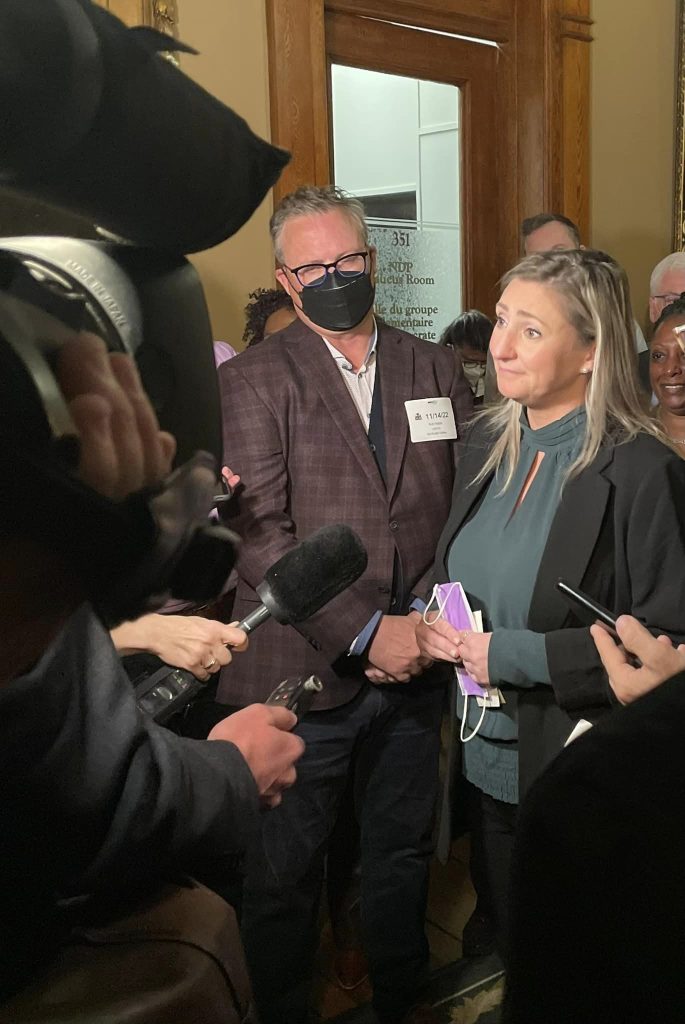
Until this contradiction is resolved, the movement will be protracted with much suffering for the workers.
However, this basic truth can be misinterpreted in a mechanical fashion. The schema sounds something like this: 1) the crisis of capitalism forces workers to struggle 2) the bankrupt reformist leadership leads each struggle to inevitable defeat 3) Marxists criticize the bankrupt leadership and grow their forces and 4) eventually, the Marxists get big enough to lead the movement to victory. This schema leads us to the inevitable conclusion that no movement will ever win unless it is led by revolutionary Marxists.
This demoralizing and fatalistic conclusion is a false caricature of Marxism that starts from a correct general truth, and forces it on every concrete situation. It can lead to passivity in the face of the living movement with revolutionaries writing them off as pre-ordained to fail due to the weakness of the Marxist Tendency. The education workers’ strike blew up this schema where without a Marxist leadership, the working class achieved a historic partial victory. It is absolutely vital not to underestimate the power of the working class. No bureaucracy is stronger than the class, and if it was, the struggle would truly be hopeless.
By a series of successive approximations, the workers kick out old bankrupt leaders, and replace them with new leaders who are more connected with the class. These new leaders are in turn tested, and those who are found wanting are also tossed aside. Old right-wingers can be pushed far to the left, right bureaucrats can be replaced by those on the left, and new individuals can rise from nowhere. The Marxists can begin to play a role in this process to the degree that we are well-organized and have learnt how to reach the workers.
We have to understand the dialectical development of class consciousness and its reflection in the leadership of the labour movement in order not to be taken off guard in the upcoming events.
The return of high inflation can be the big shock that reveals the bankruptcy of the labour leaders, and opens up the transformation of the unions. Fighting against the constant decline of their conditions, the workers will inevitably seek new leadership—a leadership that can win them better agreements and which is not afraid of the militant tactics required to win them.
This process is something we saw recently in the U.S. for example, where the 28,000 member-strong Brotherhood of Locomotive Engineers and Trainmen ousted their president. This came after the Biden administration had taken away the rail workers’ right to strike, and then worked with the union leadership to ensure the workers accepted a bad deal.
This process is even more pronounced in Britain, where the crisis of capitalism is much more advanced than Canada. There, the left was able to win the leadership of two of the biggest trade unions in the country, Unison and Unite. The trade union leaders have been pushed to declare that they would be prepared to organize illegal strike action to defeat the Tories’ anti-union laws.
What this shows is that trade unions, even when seemingly irretrievably degenerated on the surface, are still ultimately subject to the pressure of the working class and eventually end up reflecting the radicalization from below.
This is not just by the election of left-wing union leaders to oust right-wing leaders. In some exceptional cases, even some right-wing elements in the labour movement can change under the pressure of events, and take a bold stand in favour of the workers. An example of this is Tony Benn in Britain, who was on the right-wing of the Labour Party in the 1950s. But after being a minister in a right-wing Labour administration, he experienced first-hand that it was impossible to make capitalism “civilized”. He became a socialist and the main leader of the left in the Labour Party in the 1980s.
It is impossible to predict the exact course of the class struggle in Canada. But the coming fight will profoundly shake the existing bureaucracy. It will force the workers to think critically about their leaders, and new ones more in tune with the increasingly radical mood will emerge. This opens up the possibility of a left-wing leadership emerging in the unions, of a leadership composed of people closer to the rank-and-file, ready to break with business unionism, possibly even with an openly anti-capitalist and socialist view.
A left leadership in the labour movement would play a very contradictory role. First of all, we cannot have the perspective that the labour leaders, even those on the left, will always betray. As Trotsky explained back in 1926:
“The possibility of betrayal is always contained in reformism. But this does not mean that reformism and betrayal are one and the same thing at every moment. Not quite. Temporary agreements may be made with the reformists whenever they take a step forward.” (Our emphasis)
We cannot have a fatalistic view of the class struggle, where the leadership constantly betrays whatever the circumstances and the situation, unless they are revolutionary Marxists. This would be quite a crass understanding of the relationship between the class and its leaders.
The CUPE education strike which was detailed above is a textbook example of the contradictory role of the leadership, particularly of its left variety. Under the massive pressure of working class anger and left with no option, the leadership around Laura Walton played a positive role in leading the defiance of back-to-work legislation. Could it be said that they were “betraying” at that time? Not at all. Even when the pickets came down in exchange for withdrawing Bill 28, this could not in and of itself be called betrayal. The word would then lose any meaning, and we might as well say that any working class leader is always betraying except when they are leading a socialist revolution.
But this same leadership under Walton then played a negative role by accepting the lead from the right-wing, and helping to impose a bad deal on the workers. This is because, as left reformists, they constantly look over their shoulder and see the right-wing and the bosses, and lack the confidence that the working class is strong and can win.
In the period of class struggle ahead, the hold of conservative business unionism will be shaken, above all by the objective necessity for the working class to fight for its survival. This will be a very contradictory period, where left-wing leaders will emerge and carry the struggle forward, but then be found wanting because of the lack of a fully thought-out conception of how to liberate the working class.
The role of Marxists in this process is to patiently explain that all the attacks are merely just one aspect of the general crisis of capitalism. While we will support the left in the unions against the right-wing business unionist types, and any time they take a step forward in defence of the workers, we will also explain the limitations of a left reformist perspective when mistakes are made. Only with this patient attitude can the voice of Marxism connect with the workers as they go through the experience of class struggle itself , and eventually build Marxism as a mass force in the workers’ movement.
Revolutionary optimism
In the midst of the malaise in society and in the movement, the Marxists have been criticized for being optimistic. One wonders how these people expect to build anything by being so miserable.
Amongst the lefts in Canada, or what is left of the left, instead of optimism and enthusiasm, we find dissatisfaction, pessimism and despair. Articles, speeches or lectures by left-wing, socialist, and anarchist figures or organizations always emphasize how difficult the current period is for the left.
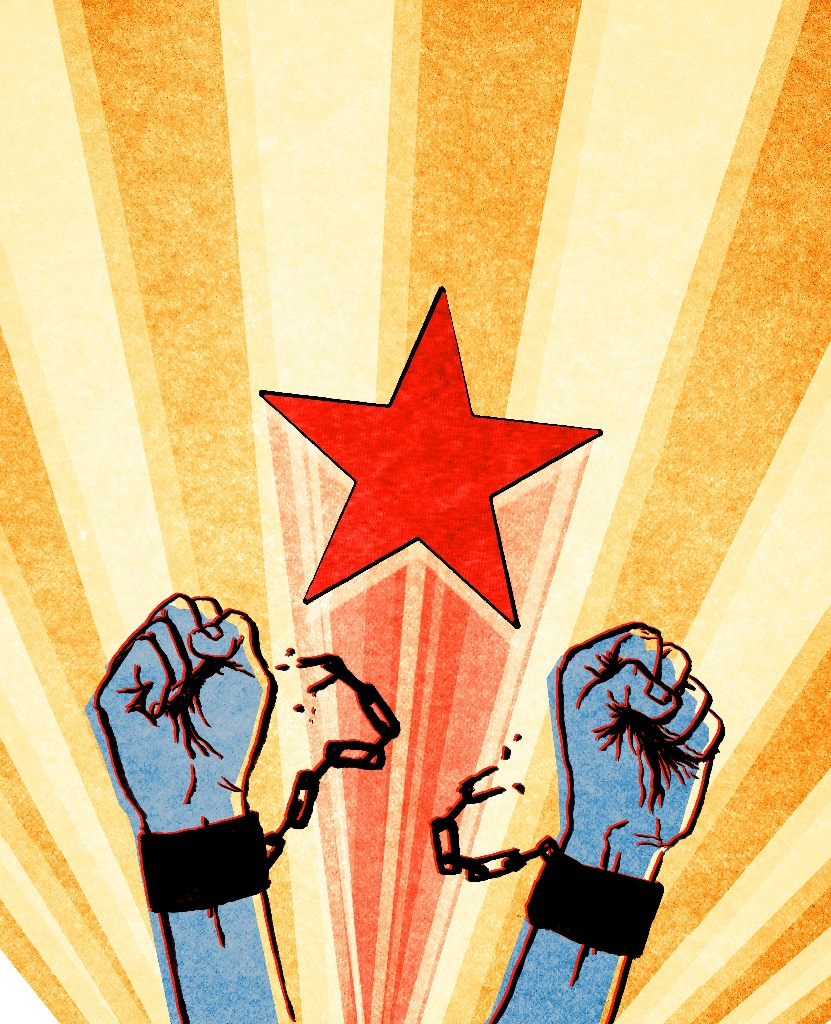
For example, in Quebec the anarcho-syndicalist IWW, which some years ago was the most visible and numerically the largest organization on the radical left, published an article last summer with this opening:
“For the past few years, we have been experiencing a crisis in activism. Many organizations are struggling to recruit and engage new members. We only have to look at our own seasonally fluctuating membership and the difficulties we face when it comes to taking action to realize that the IWW is also experiencing the effects of this same crisis.”
Another example of the mood of the left is a conference of “democratic socialists” held in October 2022 at Simon Fraser University in Vancouver. This meeting attracted the likes of left-wing economist Jim Stanford, ex-Green party leadership candidate Dimitri Lascaris, and NDP MP Mathew Green. The report of the conference reads like it was a display of skepticism, pessimism and lack of confidence in socialist ideas. We find the following comment in the intro to the report:
“In these dismal and terrifying days of early 2023 it is well to bear in mind that the quest for a fundamentally different world is still alive among us. Where it goes nobody can say. Most socialists we know are comfortable calling themselves eco-socialist these days, anti-imperialist along with anti-capitalist. The movement changes along with us. Hard times ahead for sure.” (Our emphasis)
And then, the conclusion goes as follows:
“None of the speakers expressed Polyannish utopianism (!). Several confessed their struggle with pessimism. Many themes, from foreign policy, to transforming the colonialist state, to reconciling democratic participation with economic planning, were not yet adequately addressed. But they showed that Canada’s left is lacking, not political imagination or intellectual vitality, but a proportionate voice in the public arena.” (Our emphasis)
Thankfully, no one was overly optimistic with their “utopianism”! How many times have we heard that socialists are “utopian”? And yet this report on a meeting of socialists informs us that, thank god, nobody displayed “utopianism”. How anyone attending that meeting would become enthused enough to struggle and join a socialist organization is anyone’s guess. But these are not isolated examples. The mood that pervades the left is one of cynicism, defeatism and demoralization.
There is a mood amongst the youth that, due to the lack of organized opposition, there is no way out. There is even a term for it: doomerism. A significant layer of the youth is afflicted by growing anxiety over their future. The environmental disaster in particular brings many layers of the youth to believe we are “doomed”. Many of these people are opposed to capitalism, but they do not think anything can be done about it.
In the past, Marxists would have had to work hard to convince people that capitalism cannot be reformed. The debate was socialism vs. capitalism. But now among the youth, it is really not difficult at all to convince most youth that the capitalist system does not work for the good of humanity and should be overthrown. The main debate is whether this is possible. The debate is socialism vs. doomerism.
It must be said that the lefts play a terrible role in this debate. Instead of bringing confidence and enthusiasm to the youth that reject capitalism, to the degree that they gain any influence, they feed and consolidate the skepticism, anxiety and despair that exists within a layer of the youth in particular.
Where does the pessimism among the lefts come from? At root, it comes from a complete lack of confidence in the working class. Deep down, they do not think the working class is powerful, intelligent and creative enough to change society. They tend to always exaggerate the strength of the right-wing, emphasizing only this one side of the polarization that we are witnessing. They do not think the workers want to fight and are ready for militant organizing. They also think that the workers are merely cattle to be ordered around by university educated ladies and gentlemen in suits.
By contrast to the lefts, the Marxists are incorrigible revolutionary optimists. What is the root of this optimism?
First, it is based on the complete blind alley of the capitalist system itself. The system has no future. As it drags humanity downward, this cannot but create wider and wider layers of the working class that will want to fight to change the world. We are extremely pessimistic about capitalism, which makes us optimistic for the class struggle and the socialist future of humanity.
Second is an absolute confidence in the ability of the working class to change society. The workers are not stupid or backward. The reality is that the working class is the most creative class in society. Not a wheel turn, not a lightbulb shines, not a telephone rings without the permission of the workers.
The workers are slowly re-awakening after decades of a softening of class relations. This will not be an automatic or straightforward process. But how many years can go by with high inflation and low wages before the pressure cooker explodes? As the current crisis deepens, the workers are getting hardened, losing their reformist prejudices. The working class is also being rejuvenated, with millions of radical youth entering the workforce. We can already see in embryo the results of this in the U.S. with union drives at Starbucks and Amazon. There is no force stronger than the working class once it is organized. Let no one tell you the workers will not rise up.
Lastly, our optimism is based on our belief in the correctness of Marxist ideas and perspectives. The Marxist movement has been thrown back over the past decades, mainly for objective reasons like the post-war boom. We have been reduced to a small minority. But this doesn’t scare us or demoralize us in the least. The basis of support for capitalism is rapidly eroding. Through the struggle, the working class and youth will learn that reformism, the idea of reforming the capitalist system, is the worst of all utopias. The crisis of capitalism creates the conditions where the ideas of Marxism will make sense. There has never been a better time to be a Marxist than today!
The size of the forces of Marxism are not yet equal in size to our enthusiasm and optimism. While class struggle is inevitable, we are still too small to be capable of leading the working class. We need to intervene in the movement of the workers, patiently putting forward transitional demands that make the bridge between the current needs of the working class, and the necessity of the socialist transformation of society.
The current situation in Canada is one of malaise and dissatisfaction that has yet to explode into open class struggle. But the storm clouds are gathering. This situation should imbue us with the urgency to build Fightback/La Riposte socialiste into the revolutionary party that the working class needs. We are preparing for the coming class struggle with eyes open, with full confidence in the working class and in ourselves to carry out a successful socialist revolution in our lifetime. Join us in this historic fight!


